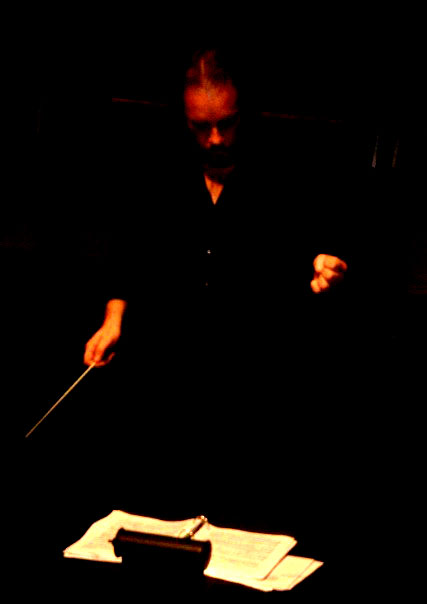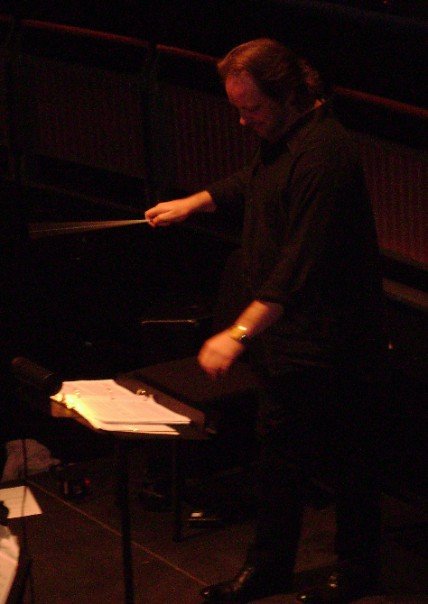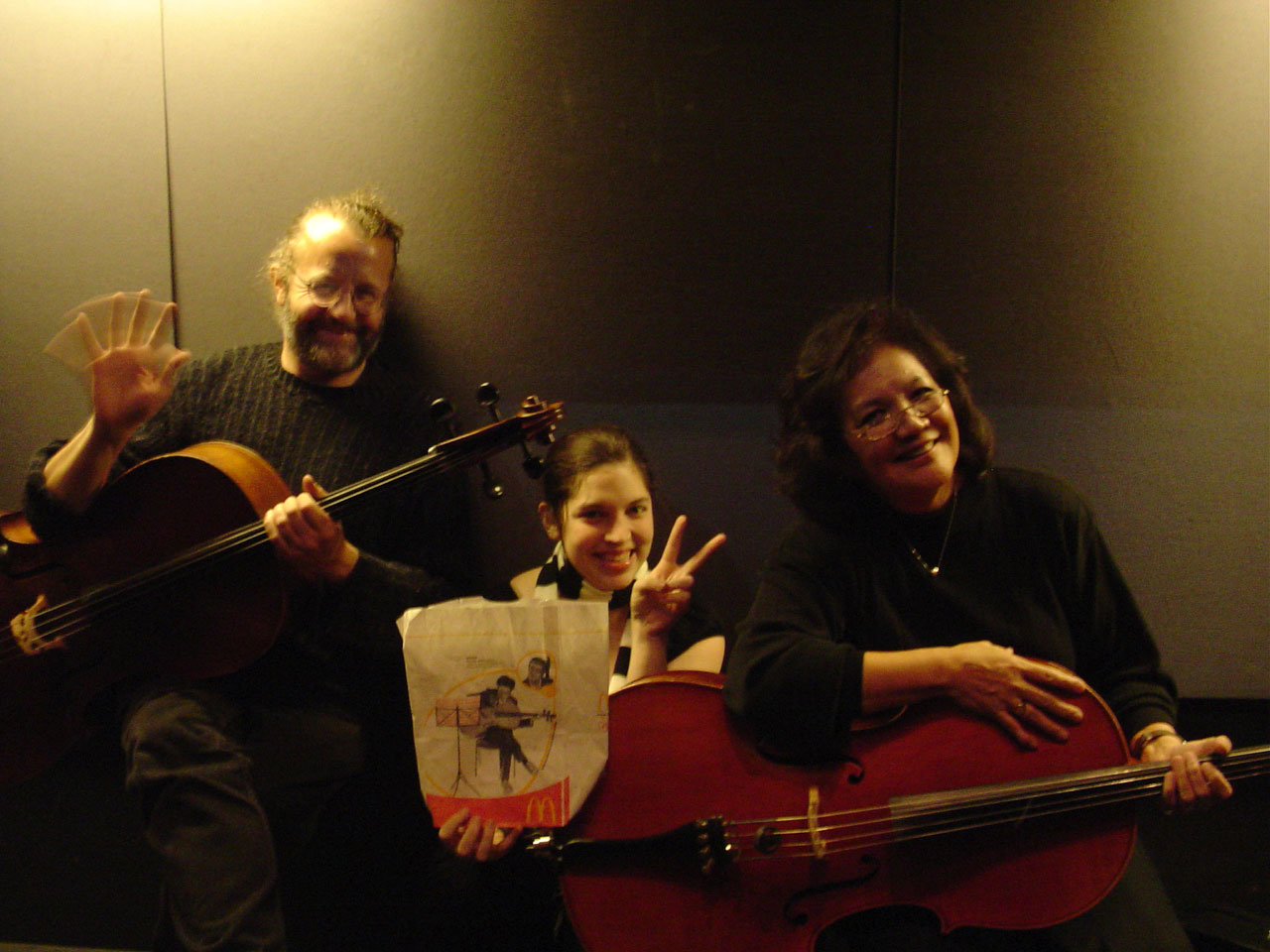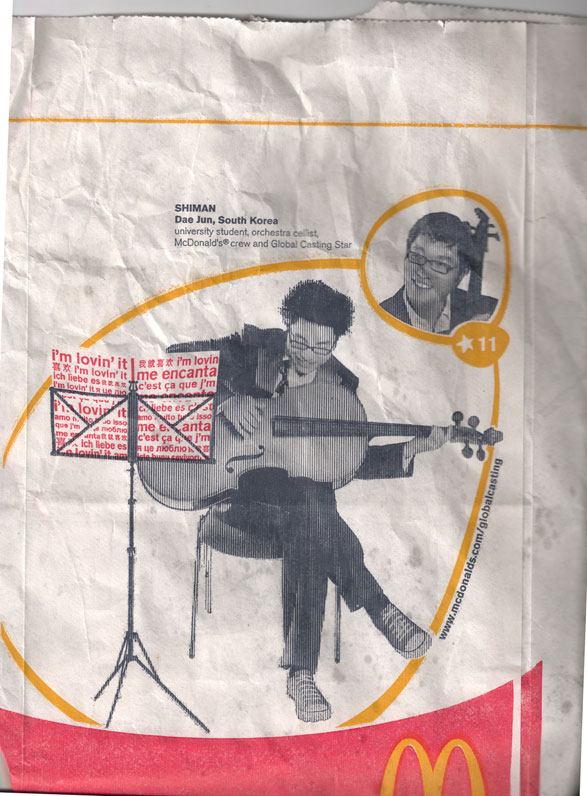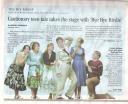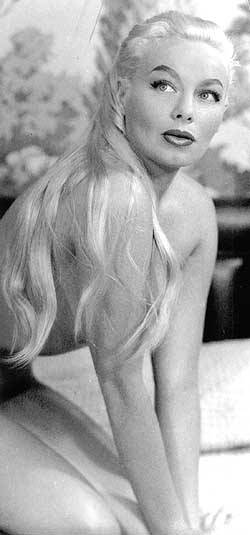Conrad Askland conducting Bye Bye Birdie in the orchestra pit at McIntyre Hall, Mount Vernon, WA – November 2007. Photos by Erin Heminway.
Dae Jun – McDonald’s Superstar
After conducting a show I stopped by McDonald’s and got my meal wrapped in the coolest Mickey D bag. One side featured Mr. Dae Jun of South Korea – a university student, orchestra cellist and “McDonald’s crew and Global Casting Star”.
So this is a shout out to Dae Jun. The top photo featuring our official Dae Jun McDonald’s bag shows Joe Bischel (left – principle cellist for the Seattle Philharmonic) and Sharon Sparling (right – also cellist with the Seattle Phil and a regular in my pit orchestras). Our official prop mistress holding the bag is Rebecca Wright (middle), my first call bass clarinet, oboe and bari sax player.
Below is a high quality scan of my official Dae Jun McDonald’s bag, complete with french fry stains. Don’t doubt for a minute that I bring you the highest quality news reports from around the world folks.
To my fashion friendly friends in LA:Â please note the dual hairstyles on the bag. That’s right. ONE bag – TWOÂ hairstyles. How can you just not totally love McDonald’s?.
Smashing Guitars
I had posted a YouTube video of a banned Mastercard commercial where a kid smashes a guitar. (Click Here for YouTube Video). Just for the record, I did in fact once have a comedian in the recording studio who did a video taping of himself smashing a brand new electric guitar just for the fun of it. He bought the guitar (I think it was a Made in Mexico Fender Strat electric) and took it right out to the parking lot to smash.
He almost broke his hand. Those guitars are very solid. I don’t know how they do it for stage dramatics, but in the real world don’t try it if you care about keeping your hands.
It looks cool when Garth Brooks does it on stage with acoustic guitars – anyone have any info on the prep they do for that? After the comedian made about fifteen jabs into the cement, and still didn’t get the explosive effect he wanted – concensus was it was kind of lame and he wasted his money.
Have a good guitar smashing story?
BBB Article in Skagit Valley Herald
November 15, 2007 article by Beverly Critchfield of the Skagit Valley Herald about Bye Bye Birdie at McIntyre Hall in Mount Vernon, WA. Cover and two large graphics you can click to read the article.
New Askland Promo Photos 11/07
New promo photos of Conrad Askland by Sergei Petrov. Click for full size. See other work by Sergei at http://www.spandas.com
Taken at The Muse in Conway, WA – one of my favorite places to jam late at night. Thank you Sergei! The graphic effects in this second shot are not very flattering, but I’ll post it up anyway.
Lamont Cranston
In the musical Bye Bye Birdie there is a line where the father character Harry McAfee says “Call the Shadow. Look him up under Lamont Cranston.” An orchestra member asked me who Lamont Cranston was and I didn’t know – so here’s everything you wanted to know about Lamont Cranston.
Lamont Cranston was one of the alter-egos of THE SHADOW. Just like Superman had a real world identity of Clark Kent.
ABOUT ALTER EGO LAMONT CRANSTON
In print, The Shadow was born Kent Allard, a famed aviator. During World War I, Allard was both a flying ace and a spy who fought for the French, and known by the alias of The Black Eagle (“The Shadow’s Shadow”), although later stories claim his alias was The Dark Eagle (“The Shadow Unmasks”). After the war, Allard sought a new challenge, and decided to wage war on criminals, rather that simply remain a pilot or return to the military (also revealed in “The Shadow Unmasks”). He faked a plane crash and Allard’s death in the South American tropical jungles. He then returned to the United States, arriving in New York City and adopting numerous identities to cloak his return.
One of these was Lamont Cranston, “wealthy young man about town.” In fact, Cranston was a separate character; Allard frequently disguised himself as Cranston and adopted his identity (see the stories “The Shadow Laughs” and “The Shadow Unmasks”). While Cranston traveled the world, Allard assumed his identity in New York. In their first meeting, with Allard/The Shadow in bed recovering from wounds, he threatens Cranston, saying that he has arranged to switch signatures on various documents and other means that will allow him to take over the Lamont Cranston identity entirely unless Cranston agrees to allow Allard to impersonate him when he is abroad. Cranston agrees. The two men sometimes meet in order to impersonate each other (see Crime over Miami). Apparently, the disguise worked well because Allard and Cranston bore something of a resemblance to each other (see “Dictator of Crime.”)
ABOUT THE SHADOW
The Shadow is a fictional character created by Walter B. Gibson in 1931 in a semimonthly series of pulp magazines. The first story was titled “The Living Shadow”. The character is one of the most famous of the pulp heroes of the 1930s and 1940s — made most famous through a popular radio series in which The Shadow was originally played by Orson Welles. The Shadow has also been featured in comic books, comic strips, television, and at least seven motion pictures. Still, The Shadow is most highly regarded for its radio years, in which pulp crime fiction received perhaps its most compelling broadcast interpretation.
Even after decades, the unmistakable introduction from The Shadow, intoned by announcer Frank Readick, has earned a place in the American idiom: “Who knows what evil lurks in the hearts of men? The Shadow knows!”
The haunting theme song, played on an organ, was “Le Rouet d’Omphale” (Omphale’s Spinning Wheel) by Saint-Saens.
Lily St. Cyr
In the Rocky Horror Show musical during the “Floor Show” segment there’s a line Janet sings: “God Bless Lily St. Cyr”. I was curious what the reference was about, so here’s info about Lily St. Cyr. (In the show it is spelled Lily St. Cyre, other incorrect spellings include Lilly Saint Sear, Lilly Saint Cear and Lily St. Seer). Cyr is pronounced like “seer”.
Lili St. Cyr (June 3, 1917 or 1918 – January 29, 1999), was a prominent American burlesque stripper.
Birth name Willis Marie Van Schaack
Born June 3, 1917
Minneapolis, Minnesota
Died January 29, 1999
Los Angeles, California
Spouse Ted Jordan
Early years
She was born as Willis Marie Van Schaack in Minneapolis, Minnesota in 1917 or 1918. She had a sister, Rosemary Van Schaack Minsky. Her grandparents, the Klarquists, reared her and her two show business sisters, Dardy Orlando and Barbara Moffett.
Having taken ballet lessons throughout her youth, she began to dance professionally as a chorus line girl in Hollywood. Unlike other women who have stroke-of-luck stories about being plucked from the chorus line and selected for a feature role, St. Cyr had to beg her manager at the club to let her do a solo act. From her self-choreographed act she eventually landed a bit part at a club called the Music Box in San Francisco, with an act called the Duncan Sisters. It was here that she came to a revelation: A dancer’s salary was only a small fraction of what the featured star’s salary was. The difference? The featured star was nude.
From the 1940s and most of the 1950s, St. Cyr with Gypsy Rose Lee and Ann Corio were the recognized acts in striptease. St. Cyr’s stage name is a patronymic of the French aristocracy, which she first used when booked as a nude performer in Las Vegas. Though she is rather obscure today, her name popped up regularly in 1950s tabloids: stories of her many husbands, brawls over her, and her attempted suicides.
St. Cyr was married six times. Her best-known husbands were the musical-comedy actor Paul Valentine, restaurateur Armando Orsini, and actor Ted Jordan in 1955.
Career
St. Cyr’s professional career started as a chorus line dancer at the Florentine Gardens, in Hollywood. Over the ensuing years and in a variety of different venues, many of St. Cyr’s acts were memorable, with names like “The Wolf Woman”, “Afternoon of a Faun”, “The Ballet Dancer”, “In a Persian Harem”, “The Chinese Virgin”, However, Quebec’s Catholic clergy condemned her act, declaring that whenever she dances “the theater is made to stink with the foul odor of sexual frenzy.” The clergy’s outcry was echoed by the Public Morality Committee. St. Cyr was arrested and charged with behavior that was “immoral, obscene and indecent.” She was acquitted but the public authorities eventually closed down the Gayety Theatre where she performed. In the 1980s, St. Cyr wrote a French autobiography, “Ma Vie De Stripteaseuse.” In the book, she declared her appreciation for the Gayety Theatre and her love for the city of Montreal.
While performing at Ciro’s in Hollywood, (billed as the “Anatomic Bomb”), St. Cyr was taken to court by a customer who considered her act lewd and lascivious. In court, St. Cyr insisted to the jury that her act was refined and elegant. As St. Cyr pointed out, what she did was slip off her dress, try on a hat, slip off her brassiere (there was another underneath), slip into a negligee. Then, undressing discreetly behind her maid, she stepped into a bubble bath, splashed around, and emerged, more or less dressed. After her appearance as a witness, as a newspaper account of the time put it, “The defense rested, as did everyone else.” St. Cyr was acquitted.
While St. Cyr starred in several movies, an acting career never really materialized. In 1955, with the help of Howard Hughes, St. Cyr landed her first acting job in a major motion picture in the Son of Sinbad. The film, described by one critic as “a voyeur’s delight”, has St. Cyr as a principal member of a Baghdad harem populated with dozens of nubile starlets. The film was condemned by the Catholic Legion of Decency. St. Cyr also had a role in the movie version of Norman Mailer’s The Naked and the Dead in 1958. In this film, St. Cyr plays ‘Jersey Lili’, a stripper in a Honolulu night-club and girlfriend of a soldier who boasts to his pals that he has her picture painted inside his groundsheet. Regrettably, heavy edits of St. Cyr’s night-club routine by censors result in some choppy editing in an otherwise finely crafted film. But St. Cyr’s movie career was short lived, and typically she settled for playing a secondary role as a stripper, or playing herself. Her dancing is featured prominently in two Irving Klaw films, “Varietease” and “Teaserama.”
St. Cyr was also known for her pin-up photography, especially for photos taken by Bruno Bernard, known professionally as ‘Bernard of Hollywood’, a premier glamor photographer of Hollywood’s Golden Era. Bernard said that Cyr was his favorite model and referred to her as his muse.
Retirement
When St. Cyr retired from the stage she began a lingerie business in which she would retain an interest until her death. Similar to Frederick’s of Hollywood, the “Undie World of Lili St. Cyr” designs offered costuming for strippers, and excitement for ordinary women. Her catalogs featured photos or drawings of her modeling each article, lavishly detailed descriptions, and hand-selected fabrics. Her marketing for “Scanti-Panties” advertised them as “perfect for street wear, stage or photography.” St. Cyr spent her final years in obscurity and in seclusion, tending to her cats.
Death
She died in 1999 under her maiden name “Willis Marie VanSchaack” in Los Angeles.
Legacy
After St. Cyr’s death, with a renewed interest in burlesque, and especially in Bettie Page, legions of new fans began rediscovering some of the dancers in Irving Klaw’s photos and movies. During this time A&E devoted a special to burlesque in 2001 which included a piece on St. Cyr.
Influences and cultural references
In 1989, one of St. Cyr’s husbands, Ted Jordan, wrote a biography of Marilyn Monroe entitled “Norma Jean: My Secret Life With Marilyn Monroe”, in which Jordan claims that St. Cyr and Monroe had a lesbian affair. The claim is widely disparaged by Monroe biographers. The publisher of Jordan’s book, Liza Dawson, editor for William Morrow and Company, makes a more credible claim in an interview with Newsday in 1989, stating that “Marilyn very much patterned herself on Lili St. Cyr – her way of dressing, of talking, her whole persona. Norma Jean was a mousy, brown-haired girl with a high squeaky voice, and it was from Lili St. Cyr that she learned how to become a sex goddess.” Lili St. Cyr is mentioned in the musical “The Rocky Horror Show”. The final line of the song “Don’t Dream It”, (sung by the character Janet Weiss, as played in the film version by Susan Sarandon) is “God bless Lili St. Cyr!”
Filmography
* Love Moods (1952)
* Bedroom Fantasy (1953)
* Striporama (1953)
* Varietease (1954)
* Teaserama (1955)
* Son of Sinbad (1955)
* Buxom Beautease (1956)
* The Naked and the Dead (1958)
* I, Mobster (1958)
* Runaway Girl (1962)
GN’R – Banned Commercials – Mastercard – Guitar Slash
Guitar Hero on South Park
The talk of the town is the latest South Park episode that parodies the video game Guitar Hero. This South Park episode is called “Guitar Queer-o” and can be viewed at 
 http://www.southparkzone.com/episodes/1113/Guitar-Queer-o.html
http://www.southparkzone.com/episodes/1113/Guitar-Queer-o.html
Videos of the SP Guitar Hero episode were posted to YouTube but taken down because of complaints by ViaCom.
I have some family members that play Guitar Hero and are REALLY into it. Guitar Hero is a video game with a guitar like controller that has buttons you push in time with the video. The videos have the original songs from hit rock bands playing. The more in time you hit the buttons with the track the more the audience screams and you become a ROCK STAR.
Of course when I watched this played the first thing I thought was “Why don’t they learn to play a real guitar?” And that’s part of what this SP episode parodies. Playing real guitar is for old people. Guitar Hero is where it’s at.
Check out the South Park episode, it’s about the funniest thing I’ve ever seen.
Joe Zawinul,Trilok Gurtu Orient Express Part1
